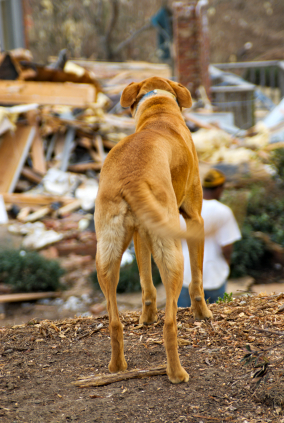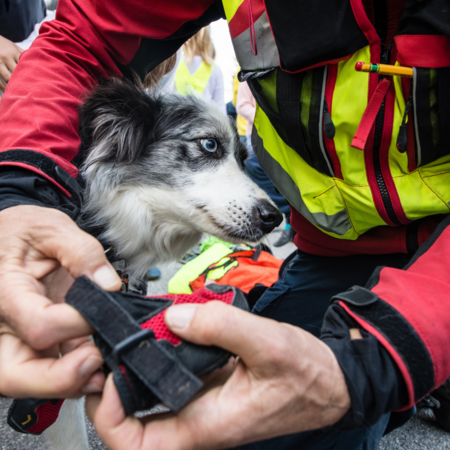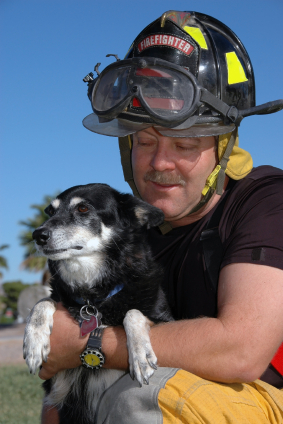An old adage recommends that we hope for the best and prepare for the worst. This is equally true of your pets, as well as your own everyday life. Obviously, no one can prepare for every possible disaster that could occur, but if you have a thorough and flexible disaster plan in place beforehand it can make managing an unfortunate situation—should one occur—much easier and less stressful. Here at PetHub we have compiled the 4 steps you need to take to create the most efficient emergency plan possible.
.png?x.rKGaLM6okk4qEDHyfxKt30RG3EK1V9)
Follow these 4 steps to make a successful emergency plan for your pet.
Step One: Preparing for natural disasters
First of all, figure out what types of natural occurrences are likely where you live. There are two kinds of disasters: natural and man-made.
Let’s start with natural disasters. Generally, they are limited by region. If you live in an area that gets a lot of snow annually, you might need to include preparations for avalanches, power loss, and being snowed in for several days in your plan. Someone who lives in the Great Plains region would be more concerned with situations like tornados, blizzards, flooding—especially if you live near creeks or rivers—and severe storms. If your home is in the area where wildfires and mudslides are common, be sure to include preparations to deal with either or both of those situations in your plan. Your plan should also take into account the amount of time it could take before help reaches you. In many cases this could only be a day or two, but in a severe disaster, you and the pets in your care could be on your own for several days or even weeks.
Man-made disasters are more widespread and can range in severity from a simple car accident to a broken gas main or house fire. On the extreme end of the spectrum are events like oil or chemical spills, train derailments, or riots.

Step Two: Make a Plan
For each situation on your list, try to determine the best and safest way to provide:
- Shelter
- Medical care
- Food for all of your animals
If you are not with the animals at the time of the incident, take into account how to safely reach them. Put your plan in writing, as in the event of an unforeseen occurrence, your mind will probably be going in several different directions at the same time. Label each section of your plan according to the action to be taken, what supplies you will need, and where they are located. Remember to include emergency phone numbers and contact information for anyone who has agreed to help you. If your plan is written on the computer, make at least two copies of it, as well as two printouts, in case of power loss. Talk about your plan with friends and family, to see what they recommend. Also, solicit advice from people in the community who work with animals daily, such as veterinarians, pet store owners, boarding facilities, and pet sitters to find out how they would handle a similar situation.

Step Three: Assemble a Disaster Survival Kit
Now that you have a written plan, the next thing you will need is a survival kit. Try to pack as much as you can in one location, so that you are not frantically searching for items in an emergency situation. Be sure that your kit includes:
- A copy of your plan (also keep a copy in your car, or purse/briefcase in case you are not home when it happens)
- Books/guides on providing first aid to different types of animals
- Extra collars and leashes on hand, in case frightened pets get out of the ones they're wearing
- Extra dishes for food and water
- Canned food for dogs and cats, and be sure you have a manual can opener and plastic spoons, to get the food out
- A small litter box and a supply of cat litter would also be a good thing to have on hand, as well as a small supply of newspaper, in case you can’t take the dogs out to the bathroom
- Crates for each animal—pets are likely to become scared and disoriented, so once they are in a safe place, away from the disaster area, make sure they are crated so they will not bolt in fear from all the commotion.
- Plenty of bottles of water
- Several flashlights and batteries on hand, in case of power loss
- Blankets for both humans and animals, regardless of what region you live in
- Animal first aid kit and several pairs of gloves, in case you have to tend to a sick or injured pet, or human
- Your pet’s Medical Records. High-tech tags, such as those powered by PetHub, link to an online profile for your pet and store critical medical information that is easy to access. If you own a PetHub Digital Pet ID Tag, make sure your pet’s profile is up-to-date. If not, consider purchasing one. It is a powerful tag that can make a big difference in keeping your pet safe.
- A written list of local and national pet safety/shelter/rescue organizations

Step Four: Have a Plan B
In case the worst happens, and you get separated from your animal, make sure you have them properly protected before disaster strikes:
- Current ID tags—especially ones like the Digital Pet ID Tags from PetHub—are terrific for identifying your pets in times of disaster. Unlike the traditional tag that has only one phone number etched on it, the PetHub tag can house tons of critical information about your pet, including a list of multiple contact points in case you don’t have your own phone with you due to the crisis at hand.
- Have a wallet card linking to your pet's information and emergency contacts in case you are injured and they're still at home
- Keep your PetHub profile updated and remember to change information if you have to move to a new location due to the disaster.
- Upload multiple, clear face shots of your pet, as well as full body shots (especially if your pet has special markings) to your pet’s profile
- Always have a collar with an updated tag on your pet—disasters don’t work on a schedule; they can happen at any time
- Once your kit is as well prepared as possible, sit down with each of your family members to go over the plan. Discuss where your pets would be most likely to hide in the event of an emergency situation and determine someone who would be willing to provide temporary shelter for your pet should you need to go to an emergency shelter that does not allow pets. Have pictures of your pet in your disaster kit that you can show to first responders and rescue workers, as well as neighbors
- Consider getting pet insurance, especially Emergency Medical Coverage that covers injuries that might occur should your pet run away during the disaster. These insurance policies greatly increase the chance your pet will get immediate care should they be injured and then found by a Good Samaritan. You can get quotes from multiple insurance providers in minutes to compare and contrast using this comparison tool.
Be prepared. Have a plan. It’s the best way to ensure your entire family stays healthy and safe during natural and man-made disasters.


